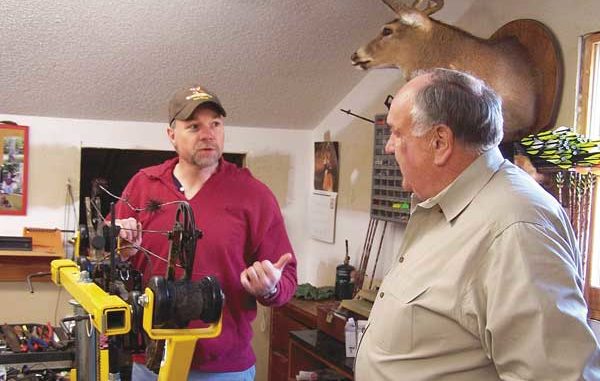
Avid bow hunters use archery equipment throughout the entire deer season that begins in September in North Carolina and usually ends Jan. 1 (during years when New Year’s Day is Sunday the season ends Jan. 2).
But most part-time hunters put away their bows after gun season begins. Either way, it’s past time to check out all hunting gear — and not only bows and arrows.
If you don’t know a good archery dealer near you whom you can count on to check out your equipment each year before bow season, consider finding one — even if it means burning an extra gallon of gasoline to make at least one annual trip to have your bow cleaned and tuned for the upcoming season.
If you shoot traditional equipment (long bows, recurves), you can visually check the limbs for hairline cracks, arrow rests that need repair and worn stings.
But compound bows are more complex. All cables and connections should be closely examined, then the bow should be put on a “press” to release all tension on cables and strings.
Cams, wheels and axles should be removed, cleaned, lubricated and reassembled, making sure they are properly tuned in the process. If cables and strings show any wear, they should be replaced.
If you plan a distant bowhunting trip (to another state or country), it’s a good idea to purchase a portable field press, just in case you have cable or string problems.
An archery pro also can fabricate a spare set of cables and strings and install nocks and peep-sights in a ready-to-go setup.
And most will give you a quick course in how to install them. It can literally save a hunt in a far away place that otherwise would be completely ruined by a broken string or cable.
Keep in mind that new cables and strings need to be shot 50 to 100 times, or more, to allow them to stretch and break in before hunting with them.
Sights need to be checked periodically at home, and every time upon arrival at a hunting destination, specially if you travel via air. Bowsights can get knocked out of alignment during baggage handling by the airlines. They also can get out of alignment because of the extreme temperature changes during airline flights.
Arrows also need a good, close annual check.
Anyone can do this by simply examining each arrow by following a few simple steps. First, make sure the shaft is straight. A spin test works best for me.
Looking straight down a shaft trying to see if it’s straight can be deceptive. Stand the arrow vertically on a smooth surface and spin it, viewing it from the side. If it’s straight and true, it will spin without any noticeable wobble. Focus on the broadhead, nock and entire shaft length. Sometime the problem isn’t the shaft but the broadhead. Another way to check for shaft and broadhead straightness is to perform what is commonly known as the “pool-cue” test. Place the arrow on a flat surface and roll it toward and away from you. If the shaft is fletched, allow the fletchings to hang over the edge of the table or whatever surface you’re using (remove the broadhead first). You also can use a straight piece of 2×4 or 2×6 board about 18 inches long and perform the pool-cue test with broadhead and fletchings attached.
Commercial spin testers are available. Pine Ridge Archery Products and Apple make these items, priced from $25 to $35.
Next check the fletchings. Are they still securely glued in place? If you find one that’s even the slightest bit loose, it’s best to completely refletch all vanes on the arrow.
Then examine nocks to make sure they’re securely glued to the backs of shafts. Pinch nocks to see if either side is cracked or broken, then nock on your bowstring to see if they snap on securely. An extra drop of fletching glue on the front and back end of each nock will help keep them attached.
Probably the most important components of hunting arrows are broadheads. All broadheads, which come in a variety of designs and weights, should weigh the same. I prefer a 125-grain broadhead for North American big game because it’s a good match for my bow, the way I shoot, and offers top penetration. But broadhead choices are a matter of preference for individual bowhunters.
Just make sure your broadheads are screwed on tightly and be sure to use a broadhead tool every time you attempt to tighten or loosen a broadhead.
I learned the hard way. It occurred the night before opening day of bow season about eight years — and 18 stitches — later. It was a painful but valuable lesson.
If the blades on your broadheads are assembled with screws or clips, check to make sure they’re still securely attached. Of course, make sure the blades are razor sharp.
But be careful working with broadheads. Even a dull blade will do a quick number on your fingers if handled carelessly.
More next month about stand preparation and site selection for deer season.
And remember to shoot straight and be smart.
***
Ramon Bell of Stokesdale is president of the N.C. Bowhunters Association and an official measurer for NCBA, Pope&Young and Boone and Crockett clubs. Check out www.ncbowhunter.com or contact him at 336-643-4455 or e-mail oldsouthadv@yahoo.com.



Be the first to comment